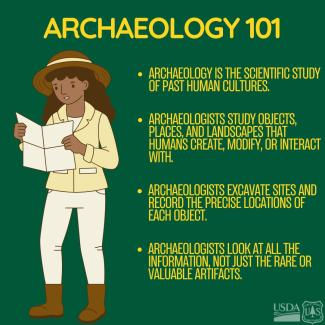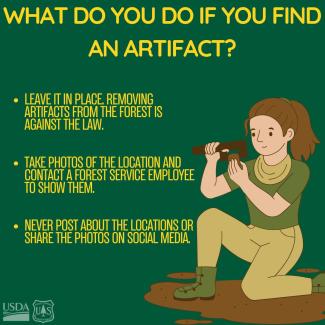Archaeology and Cultural Resources
Artifacts 101: Understanding Responsible Recreation on the MBS

What Is an Archeological Artifact?
“Artifacts” are the things that past peoples made, changed, and left behind where they lived and worked. Archeology is the scientific study of past human cultures. Archeologists excavate artifacts from archeological sites.
Leave It Be
Artifacts are not souvenirs! Leave the artifact where you found it. Please don’t pick it up, move it, throw it, put it in your pocket or your bag, or bury it.
Document the Location
Note where you are. Snap a picture of the artifact where you found it. Step back and photograph the artifact with a landmark. Please don’t post them on social media.
Alert a Forest Ranger or Visitor Services Specialist
Show a forest ranger or visitor services specialist your pictures and the location of the artifact. If you cannot find a ranger, use the “Contact Us” form on the MBS website to email the information.
Taking Artifacts Is Illegal
Federal law protects archeological sites and artifacts on federal lands. You may not dig, collect artifacts, use metal detectors, or deface rock images in national forests. Violations may result in jail time or fines, as well as confiscation of equipment. See the Archaeological Resources Protection Act (ARPA) at 16 USC 470 § aa-mm and the associated regulations at 43 CFR 7. Additionally, collecting artifacts is not the right thing to do. By leaving artifacts in place, you help to preserve the condition of archeological sites. Keeping sites intact enables archeologists to study the past and share its stories with you. The MBS needs your help to preserve and protect archeological resources for everyone to appreciate.
If You See Something Wrong
Please notify a ranger immediately if you observe someone removing artifacts, damaging sites, or rock images, or using metal detecting equipment on forest land.
Collecting Artifacts: What you need to know and why we don’t do it.

Archaeology is about studying material remains and environments to understand the past. Archaeologists carefully excavate a site and record the precise location of each object and feature. They make this special effort because any kind of digging is destructive. As soon as we take an artifact out of the ground, we lose lots of other information.
In most cases, we don’t dig if we don’t have to. It takes a lot of time, effort, and money to do good archaeology. After we excavate artifacts, archaeologists are responsible for doing analysis, sharing that information, and keeping the artifacts safe and stable. We know about important sites all over the MBS that haven’t been intensively excavated. And if they’re not under threat, that’s OK. When we do excavate a site to understand it, we often only remove a sample of the artifacts. Archaeologists in the future may have access to tools and technologies that can tell us more than we could ever know today.
Archaeologists look at all the information, not just rare or valuable artifacts. We don’t sell artifacts. In fact, if you show us something and ask us what it’s worth, we probably won’t even know. Something as regular as an old trash dump can tell us amazing things about the daily lives of people or broad patterns of history, but only if we can study all the materials together.
Digging artifacts without keeping field records makes understanding history impossible.
When we see unfortunate news stories about illegal metal detecting and site destruction at an archaeological site, we often see questions like these in the online comments:
Aren’t these cool things just rotting away in the ground? Let’s get them out so people can enjoy them!
This is both true and false. It’s true because nothing lasts forever. An iron object buried in the soil for 150 years is definitely going to corrode. However, digging it up could actually make it worse by “shocking” the material. It takes a lot of training to learn how to conserve artifacts and sometimes washing or coating objects can even cause long-term problems. Only in the rarest cases do we rush to remove objects from the ground.
Sometimes we choose not to dig specifically because the sites may be so very important. This is especially true for places of burial. For example, what looks like a village site is also very likely to be a burial place for the ancestors of today’s Tribes. Besides the fact that knowingly disturbing human burials is against the law, the places and people who hold them sacred deserve our respect.
What about collecting artifacts I see on the surface?
If you’re on private property and have permission of the landowner, there’s nothing preventing you from doing this. But remember that records of your find are important. If you’re not prepared to fully document your collection and to take care of the objects you collect forever, they’re better off staying where they are. If you think you’ve found something special and want to make sure it’s recorded so that others can know more about our material culture, contact us.
Remember: It’s always illegal to remove artifacts from state or federal land, or from bottomlands of creeks, rivers, and other bodies of water, without permits.
I love history and artifacts, but I don’t have a college degree in archaeology. How can I get involved?
Interested members of the public should check out the Association for Washington Archaeology. There are chapters throughout the state that meet regularly. By working with AWA, you can learn about all kinds of Washington sites and artifacts and get hands-on training and experience.



